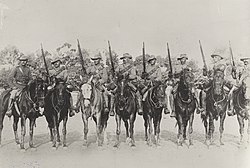South Australian Mounted Rifles
| South Australian Mounted Rifles | |
|---|---|
 2nd South Australian Mounted Rifles training in Adelaide, prior to deployment to South Africa, early 1900. Trooper Harry Morant is third from left. | |
| Active | 1899–1901 |
| Country | |
| Allegiance | British Empire |
| Type | Mounted infantry |
| Size | Initial:
|
| Engagements | Colony of South Australia that served in the Second Boer War . The first contingent of South Australian Mounted Rifles was raised in 1899, followed by a second contingent in 1900.
The first contingent, an infantry company, arrived in South Africa in late November 1899, and served with the Transvaal , the first contingent and a small portion of the second contingent returned to Australia in November, while the remainder served in Transvaal until March 1901, when they too returned to Australia.
HistoryAn unrelated militia unit with the same name was formed by the merger of the South Australian Adelaide Lancer and mounted rifle militia units in 1895.[1] 1st contingent The 1st South Australian Mounted Rifles (SAMR) were raised as the South Australian Infantry Company in late 1899, under the command of Captain Frederick Henry Howland. The company was mostly composed of men with prior military experience, and numbered six officers and 121 men; it had no relation to the militia unit of the same name. It embarked at Port Adelaide aboard the troopship Medic on 2 November, disembarking at Cape Town on 25 November, where they camped at Maitland until 1 December. On that day, the company moved to De Aar by train, after which they marched to Belmont, joining the Australian Regiment there.[2] With the regiment, it marched to Enslin on 10 December to relieve the Gordon Highlanders under the orders of Lieutenant-General Lord Methuen, after which it was held in reserve at the Battle of Magersfontein, in which it did not participate.[3] During these operations, the company helped to guard the railway line from De Aar to the Modder River.[4] The company returned to Major-General Ralph Arthur Penrhyn Clements, holding positions in front of Colesberg.[4] It lost an officer killed at Pink Hill on 12 February, when Clements' force was attacked by a superior Boer force. Following the engagement the British retreated towards Rensburg and to Arundel on the night of 13–14 February, where the regiment suffered multiple casualties while serving as the rearguard of the column. After reaching Arundel, Acting Adjutant Captain G.R. Lascelles of the Royal Fusiliers went back to the battlefield with a mainly 1st SAMR mixed volunteer group to "help infantrymen who had been left behind."[3][5]
 The 1st SAMR joined the 2nd Battalion of the Inniskilling Dragoons under Major Dauncey, on the right of Clements' force.[6] The first and second contingents united at Bloemfontein to form the SAMR.[3][2]
2nd contingent and unified SAMRThe 2nd SAMR was raised as a mounted infantry squadron from the same types of men as the 1st contingent. It numbered seven officers and 112 men, under the command of Captain Charles James Reade. Among its men was J Battery Royal Horse Artillery.[6][9] During its independent operations the squadron was under the overall command of Generals William Forbes Gatacre and Reginald Pole-Carew.[10]
 At Bloemfontein, the unified South Australian Mounted Rifles joined the Fourth Corps of the 1st Mounted Infantry Brigade, along with the Victorian Mounted Rifles, Tasmanian Mounted Infantry, 4th Battalion Imperial Mounted Infantry, J Battery Royal Horse Artillery, and two QF 1-pounder pom-pom guns, providing reconnaissance for the army of Field Marshal Frederick Roberts. The SAMR fought in the Karee-Brandfort action, under the command of General Charles Tucker, losing at least one wounded and one captured. It served as the advance guard of Pole-Carew's 11th Division in the march to Johannesburg,[10][11] capturing seven engines while cutting the Pretoria railway under fire at Elandsfontein on 29 May.[12] On the morning of 30 May fifty men of the SAMR under Battle of Belfast on 7 September, the last pitched battle of the war, in which they suffered multiple casualties.[10][11]
After Belfast, the SAMR marched along the Barberton, and Hectorspruit. The unit found abandoned Boer guns near Komatipoort, where they participated in a review in honour of the birthday of Carlos I, King of Portugal at Komatipoort, then returned by train to Pretoria on 9 October, where it camped at Sunnyside. The first contingent and 25 men of the second contingent departed from Cape Town aboard the troopship SS Harlech Castle on 3 November, arriving at Adelaide on 30 November. There, these soldiers were given a bonus of 30 days' pay by the South Australian Government and were disbanded. The remainder of the second contingent was attached to Brigadier-General Edwin Alderson's Mounted Infantry Brigade, serving in east and northeast Transvaal until March 1901. On 29 March the remaining men departed Cape Town[11] aboard the transport Tongariro, arriving at Sydney on 1 May. Moving overland to Melbourne, the remaining portion of the 2nd SAMR participated in the Commonwealth inaugural celebrations before reaching Adelaide on 12 May,[2] where it was given a bonus of 30 days' pay by the South Australian government, being disbanded three days later.[10]
Casualties, decorations, and battle honours The first contingent suffered casualties of two killed or died of wounds, one captured, In 1903, the militia unit known as the South Australian Mounted Rifles was expanded into the 16th and 17th Australian Light Horse Regiments. Both regiments received an honorary banner for South African service in 1904 and the honorary distinction South Africa 1899–1902 for the service of the SAMR in the Boer War in 1908; both were awarded to units who had more than twenty members serve in the war.[14] The battle honour South Africa 1899–1902 is carried by the 3rd/9th Light Horse (South Australian Mounted Rifles), which perpetuates the unit.[15] Notes
References
Further reading
External linksWikimedia Commons has media related to South Australian Mounted Rifles. |
